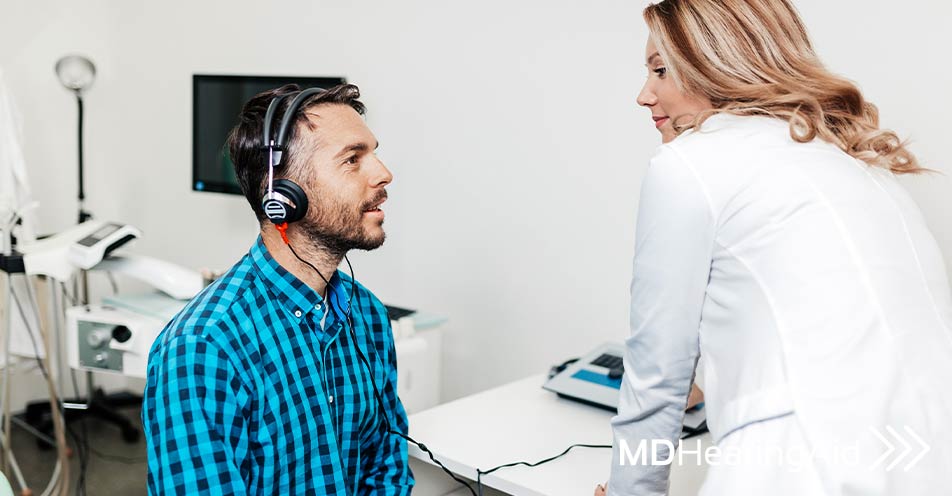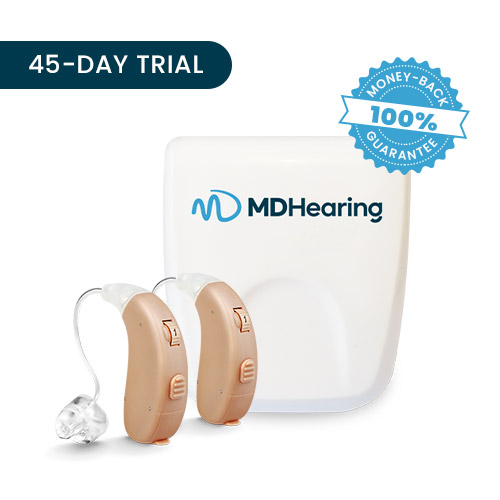Choosing the right hearing aid isn’t always easy. Not only do many patients have budget constraints that limit them to a certain price spectrum, but different patients have different types of hearing loss.
To reduce the guesswork and match patients with the best hearing aids for their hearing loss, audiologists conduct a variety of hearing tests. Basic pure-tone hearing tests are still the gold standard in fitting hearing aids (like our online hearing test), yet now, speech hearing tests that simulate real-world noise conditions – called speech-in-noise (SIN) testing – are adding even more detail to existing hearing assessment methodologies.
Below, we’ll help you understand what speech-in-noise testing entails, how it works, and how it can provide more detail to a normal hearing loss assessment.
Why Should You Consider Speech-in-Noise Testing?
The first complaint most hearing loss patients report is the inability to understand voices in noisy environments. Therefore, it makes sense that hearing loss evaluations should simulate listening to speech in noise – as SIN testing does – to evaluate your comprehension abilities in these situations.
Moreover, a survey of patients with hearing aids revealed that the most common problems patients encounter with their hearing aids is poor performance in noisy environments. Here’s what the survey found about hearing aid performance in noise:
- 14% of hearing aid users were not happy with the performance of their hearing aids in noise.
- 11% of hearing aid users “loved” the performance of their hearing aids in noise.
- 75% of hearing aid users said they were somewhere between “loving” and “being dissatisfied with” their hearing aids in noise.
All in all, these points make a strong case for why you should request a speech-in-noise (SIN) test for the most accurate assessment of your hearing loss possible.
What Does SIN Testing Tell Your Audiologist?
SIN tests simulate a wide variety of real-world speech-in-noise listening conditions. This provides your audiologist or hearing care provider with detailed insights into your condition, not only to select an appropriate hearing aid but also to achieve the most effective fine-tuning of your hearing aid.
Here are the kinds of questions SIN testing can answer for your audiologist:
- Do you need a hearing aid with directional microphones?
- Do you need the most powerful noise reduction technology?
- Do you need a hearing aid with “signal processing” to reduce background noise distractions?
- Do you need any of these features at all?
If you’re lucky, the fourth question will apply to you – and SIN testing will reveal that you don’t need any expensive bells and whistles on your hearing aid, and the most inexpensive solution will suffice. On the other hand, if you do need advanced hearing aid features, SIN testing will help your audiologist pinpoint exactly what kind of hearing aid to select, and what kinds of results you can expect from using the device.
By evaluating these factors, the SIN test provides patients and audiologists with the insights they need for the best hearing aid selection and fine-tuning. That way, patients are more likely to use their hearing aids and receive the benefits they’re looking for – instead of simply putting their hearing aids aside.
Types of SIN Tests
There are a variety of speech-in-noise tests that audiologists use to evaluate hearing. These include:
- Hearing in Noise Test (HINT): The HINT plays pre-recorded statements with key words in them that the test taker needs to identify and understand.
- Words in Noise (WIN): The WIN is a test distributed by the VA. It plays different monosyllabic words that must be identified in different simulated background noise conditions.
- QuickSIN: The QuickSIN can be obtained through Etymotic Research. It’s a sentence-based listening test for adults where recordings are played in different simulated background noise conditions.
- Bamford-Kowal-Bench SIN (BKB-SIN): This test is similar to QuickSIN, but it is appropriate for both adults and children.
- Connected Speech Test (CST): This test is given in paragraph form, sentence by sentence, under a selected fixed background noise level. The test determines the ability to hear and comprehend connected speech.
- Speech Perception in Noise Test (SPIN): This test evaluates the ability to hear sentences under a selected fixed background noise level.
Hearing Loss Isn’t Always in the Ears
Your ability to understand speech in noise isn’t always about your ears. While your ears’ ability to hear voices clearly is essential to understanding speech, your brain also needs to process the language for complete comprehension. Some patients compensate for hearing loss with highly-developed speech processing skills. If they miss a few words, their brains can still interpret the gist of what people are saying.
A hearing loss patient could be suffering from ear damage, a central auditory nervous system disorder, cognitive decline – or all of the above.
- Are you suffering from cognitive decline?
- Are you suffering from ear damage?
- Are you suffering from a central auditory nervous system disorder?
- Are you suffering from all or just one of the above?
Imagine that your SIN test reveals that no hearing assistance techniques are able to help you overcome your hearing loss challenges. Your hearing care provider can then refer you to a medical practitioner for cognition testing to ensure that you aren’t suffering cognitive decline. The sooner you know, the sooner you can treat the right problem to improve your hearing.
Ask Your Audiologist About SIN Testing for the Most Accurate Hearing test
SIN testing simulates real-world background noise conditions, requires you to listen to and try to understand voices in noise, and it can be used to test your hearing while you try different types of hearing assistance.
Considering the superiority of SIN testing, you should ask your hearing care provider for SIN (speech-in-noise) testing before selecting a hearing aid. This will ensure that you don’t waste money on a hearing solution that isn’t going to work, and it will help you fine-tune your hearing aid effectively. Ultimately, getting SIN testing can make you happier with the performance of your hearing aid in the long run.
MDHearing: Send Your Hearing Tests Results to Our Audiologists!
At MDHearing, we recommend that you visit a hearing clinic or audiologist for a professional hearing exam before choosing one of our products. We also recommend that you ask for SIN testing to ensure you get the most accurate hearing test results.
Then you can send your test results to the audiologist team at MDHearing. We’ll review your test results and recommend which MDHearing product is best for your needs.
Shop MDHearing Products
At MDHearing, we sell high-quality, FDA-registered hearing aids for thousands of dollars less than comparable brands. Priced between $399.99 and $1,199.99 per pair, MDHearings products also come with a 100% money-back guarantee, so there’s no risk in giving them a try.
After ordering your hearing aid from MDHearing, you’ll receive it in just a few days. Our on-call hearing aid specialists can walk you through the process of adjusting and fine-tuning your hearing aid to fit your hearing loss profile.
Here are three of our most popular hearing aids:
- MDHearing AIR: Priced at just $399.99 per pair, the AIR features advanced digital technology, feedback cancellation, and settings for four listening environments (quiet, social, noisy, and restaurant).
- MDHearing VOLT: Priced at just $599.99 per pair, the VOLT is our rechargeable model that features intelligent directional microphones, feedback cancellation, and background noise management technology to clarify sounds in four different listening environments.
- MDHearing CORE: Priced at just $1,199.99 per pair, the CORE offers Bluetooth connectivity and a smartphone app for easy fine-tuning and adjustments. It also features intelligent directional microphones, feedback cancellation, and background noise management technology to clarify important sounds and voices in four listening environments.
To learn more about MDHearing and its catalog of affordable, high-quality digital hearing aids, browse our website now.
BROWSE HEARING AIDS


